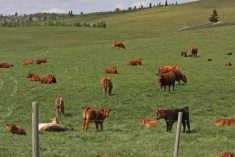WILLIAMS LAKE, B.C. – By teaching high school students to cook roast beef or elementary schools to grow potatoes in tubs, British Columbia’s Agriculture in the Classroom program is reaching thousands of youth each year.Program co-ordinator Lindsay Babineau started the program with the ministries of agriculture and education, which provided her with a computer and a bare bones office in Abbotsford, B.C.Today the former high school teacher has helped publish a children’s book, delivers hands on activities to show kids where their food comes from and helps develop the curriculum.“I think what Agriculture in the Classroom has been able to do in the last five years is to spark an interest in the general child population in agriculture,” she said after the B.C. Cattlemen’s Association annual meeting in Williams Lake, B.C., May 28-29.One of the success stories is publishing 3,000 copies of a glossy, hard cover children’s book called Alfalfabet . Posters on the Alfalfabet theme are also available.Agriculture in the Classroom has formed a partnership with B.C. Women’s Institutes, where members deliver the book to schools across the province.Participating schools are invited to explore why agriculture and farms are needed in a community.The children have discussions or make posters or other crafts to illustrate their answers.“It has been incredibly popular because kids are making the connection why is a farm or why is a ranch something that is really important to us,” said Babineau.She worked with a children’s author and illustrator to get the book, printed by Vancouver Kids Books, into schools as well as on store shelves.“We started to look around for children’s books on agriculture and they were all quite stagnant and old. There were old black and white photos with nothing too exciting,” she said.At the elementary school level, the Spuds in Tubs program was introduced to 4,500 children two years ago. Children plant potatoes in large containers, care for the plants and later eat their harvest.The Take a Bite of BC program includes 14 high school culinary arts programs. School chefs collect locally grown products from 22 commodity groups and teach students to prepare dishes that are later served in school cafeterias.Students cook about 500 meals per day. Next year, 40 schools will offer the program.
Read Also

Know what costs are involved in keeping crops in the bin
When you’re looking at full bins and rising calf prices, the human reflex is to hold on and hope for more. That’s not a plan. It’s a bet. Storage has a price tag.















